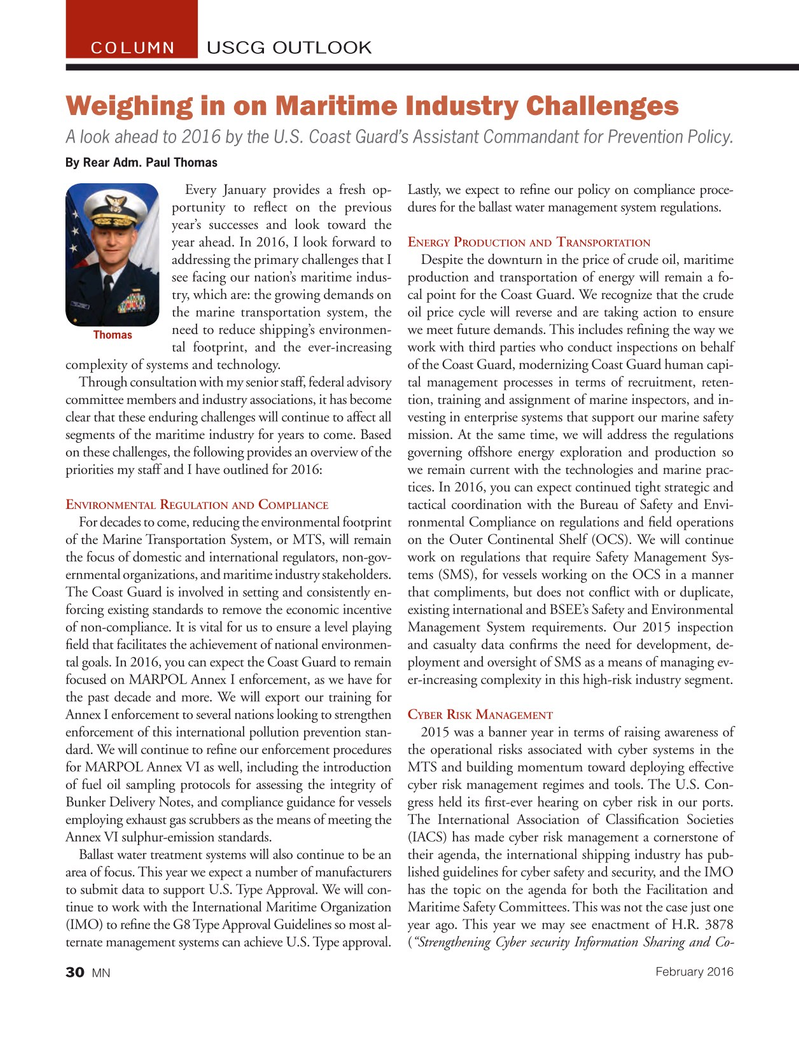
Page 30: of Marine News Magazine (February 2016)
Dredging & Marine Construction
Read this page in Pdf, Flash or Html5 edition of February 2016 Marine News Magazine
COLUMN USCG OUTLOOK
Weighing in on Maritime Industry Challenges
A look ahead to 2016 by the U.S. Coast Guard’s Assistant Commandant for Prevention Policy.
By Rear Adm. Paul Thomas
Every January provides a fresh op- Lastly, we expect to re? ne our policy on compliance proce- portunity to re? ect on the previous dures for the ballast water management system regulations. year’s successes and look toward the year ahead. In 2016, I look forward to E P T
NERGY RODUCTION AND RANSPORTATION addressing the primary challenges that I Despite the downturn in the price of crude oil, maritime see facing our nation’s maritime indus- production and transportation of energy will remain a fo- try, which are: the growing demands on cal point for the Coast Guard. We recognize that the crude the marine transportation system, the oil price cycle will reverse and are taking action to ensure need to reduce shipping’s environmen- we meet future demands. This includes re? ning the way we
Thomas tal footprint, and the ever-increasing work with third parties who conduct inspections on behalf complexity of systems and technology. of the Coast Guard, modernizing Coast Guard human capi-
Through consultation with my senior staff, federal advisory tal management processes in terms of recruitment, reten- committee members and industry associations, it has become tion, training and assignment of marine inspectors, and in- clear that these enduring challenges will continue to affect all vesting in enterprise systems that support our marine safety segments of the maritime industry for years to come. Based mission. At the same time, we will address the regulations on these challenges, the following provides an overview of the governing offshore energy exploration and production so priorities my staff and I have outlined for 2016: we remain current with the technologies and marine prac- tices. In 2016, you can expect continued tight strategic and
E R C tactical coordination with the Bureau of Safety and Envi-
NVIRONMENTAL EGULATION AND OMPLIANCE
For decades to come, reducing the environmental footprint ronmental Compliance on regulations and ? eld operations of the Marine Transportation System, or MTS, will remain on the Outer Continental Shelf (OCS). We will continue the focus of domestic and international regulators, non-gov- work on regulations that require Safety Management Sys- ernmental organizations, and maritime industry stakeholders. tems (SMS), for vessels working on the OCS in a manner
The Coast Guard is involved in setting and consistently en- that compliments, but does not con? ict with or duplicate, forcing existing standards to remove the economic incentive existing international and BSEE’s Safety and Environmental of non-compliance. It is vital for us to ensure a level playing Management System requirements. Our 2015 inspection ? eld that facilitates the achievement of national environmen- and casualty data con? rms the need for development, de- tal goals. In 2016, you can expect the Coast Guard to remain ployment and oversight of SMS as a means of managing ev- focused on MARPOL Annex I enforcement, as we have for er-increasing complexity in this high-risk industry segment.
the past decade and more. We will export our training for
YBER ISK ANAGEMENT
Annex I enforcement to several nations looking to strengthen C R M enforcement of this international pollution prevention stan- 2015 was a banner year in terms of raising awareness of dard. We will continue to re? ne our enforcement procedures the operational risks associated with cyber systems in the for MARPOL Annex VI as well, including the introduction MTS and building momentum toward deploying effective of fuel oil sampling protocols for assessing the integrity of cyber risk management regimes and tools. The U.S. Con-
Bunker Delivery Notes, and compliance guidance for vessels gress held its ? rst-ever hearing on cyber risk in our ports. employing exhaust gas scrubbers as the means of meeting the The International Association of Classi? cation Societies
Annex VI sulphur-emission standards. (IACS) has made cyber risk management a cornerstone of
Ballast water treatment systems will also continue to be an their agenda, the international shipping industry has pub- area of focus. This year we expect a number of manufacturers lished guidelines for cyber safety and security, and the IMO to submit data to support U.S. Type Approval. We will con- has the topic on the agenda for both the Facilitation and tinue to work with the International Maritime Organization Maritime Safety Committees. This was not the case just one (IMO) to re? ne the G8 Type Approval Guidelines so most al- year ago. This year we may see enactment of H.R. 3878 ternate management systems can achieve U.S. Type approval. (‘‘Strengthening Cyber security Information Sharing and Co-
February 2016
MN 30
MN Feb16 Layout 18-31.indd 30 1/21/2016 11:32:51 AM

 29
29

 31
31
